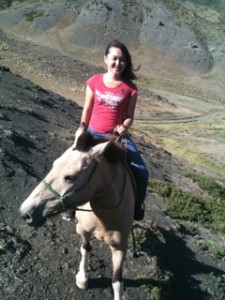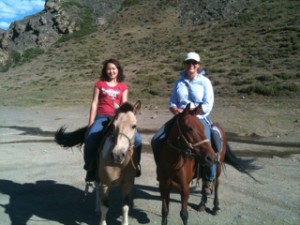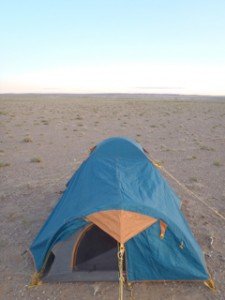
Gobi accomodation
Well, here comes another rant on my time in Mongolia, it’s pretty difficult to encapsulate the privileged experience that has been mine for the past few weeks learning about one of the oldest herding cultures left on earth, but it’s a long plane trip home and I can enjoy a one way conversation.
The privilege has been sharing a moment in these people’s lives, laughing over a bowl of tea, cuddling their babies, trying to both understand their herding life and describe mine, lamenting the loss of livestock they experienced last winter, explaining how we survive long dry periods and trying to understand how they can build their animal numbers up quickly enough to remain “viable” when they can’t buy livestock in and have little opportunity to source outside income. We shared their concern about dropping well water levels, changes bought by mining and the exodus of youth to the city. I took with me a collection of photos from home, mostly of livestock and the landscape and some of my family and left a trail of these photos behind me as gifts to herders who would gratefully tuck them into the wall or ceiling of their ger amid pots, ladles, motor bike parts, bridles and Buddhist statues.
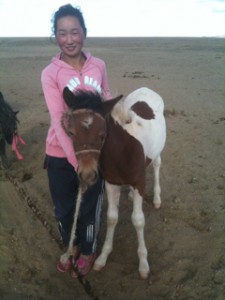
future herder
I guess what surprised me most was the fact that I could identify with the herders of the Gobi more so than I could with the goat producers I met in the United States last March who are often protected with alternative income streams from gas, oil and hunting and subsidised fodder. This parallel with a 3rd world country seems a little absurd given that Australia is such a wealthy nation but so much of our wealth is contained in the green belt following our south-eastern coastline that the outback or “inner circle” as I like to call it is similar to Mongolia in that it shares both a lack of infrastructure and services as well as being at the mercy of a pretty harsh climate, though thankfully not as harsh as Mongolia’s.
The Mongolian people have experienced dramatic change since privatisation in the mid 1990’s. During Negdel (socialist) times herders cared for a set number of government owned livestock, around 150 small animals per family, and were permitted to have 75 of their own animals, any losses of government livestock had to be replaced from their own herds. Veterinary care, doctors, education and transport were provided and on the surface it sounds like life was better for herders then, but as one old man told us, though it sounds good, it wasn’t. They were told when and where they could move, they lost their independence and taking independence from a Mongolian herder would be akin to asking an Australian pastoralist to surrender their autonomy. With privatisation in the mid 1990’s, herder and livestock numbers increased resulting in an increase in grazing pressure. It seems that there was also a change in herd dynamics as herders increased goat numbers in an attempt to cash in on strong cashmere prices. I’d make the assumption (dangerously) that it was and still is cashmere that pays for education, mobile phones, TV’s, satellites and motor vehicles. Camels, sheep and horses are herder’s subsistence animals due to their ability to survive tortuous winters. Going into a tough winter some herders will only breed their camels to provide their families with milk in the summer, keeping their softer animals dry to help them make it through the winter and even tougher spring. Goats, with their lack of subcutaneous fat are the first to die, literally freezing to death and so represent a liability in the herd structure. In reality, it’s just another example of the market driving risky and perhaps inappropriate agriculture. Animal numbers were significantly reduced after a harsh winter in 2002 and again last winter, a tough though seemingly necessary cycle to maintain balance in the landscape.
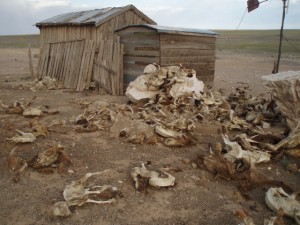
winter carnage
Chart on livestock numbers in Omnigobi aimag from 1960 to 2007. Figures provided by Jane Addison- Thanks J
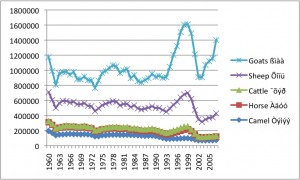
After around 20 interviews or so I started to get a sense of the role personal “drive” played in the success of these herders, much the same as it does anywhere I guess. As I see it there are two critical factors determining coming through winter in reasonable shape; the ability and willingness to move regularly throughout the summer providing livestock with the best pasture possible to maximise the “fat bank” in each animal, and harvesting as much fodder as possible during the summer to feed livestock when they are holed up in their winter camp. I think personal “drive” has a massive effect here because it’s a lot of work to regularly pack up and move camp following the grass. Once camels were used to transport herder’s belongings and while this was harder and slower than using a motor vehicle, it was less expensive so I think it’s possible that now the number of summer moves are also affected by a family’s available finances. Collecting forage by hand is arduous work, mostly done by the men who sometimes see it as an opportunity for a vodka drinking session with their mates. Obviously the less fodder you have squirreled away for winter, the more at risk you are of your livestock starving to death when energy requirements far outweigh available forage.
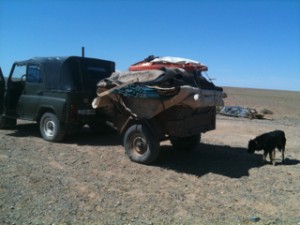
a ger in transit
We met one herder who had spent the last 3 years away from his home turf, following the grass, sort of like us having our stock in the “long paddock’ for 3 years. He was a fairly broken man when we chatted and it was hard to see how he could pull himself out of the situation that the climate had thrown him into. He’d had 700 animals last summer, making him quite a wealthy and successful herder. Last autumn he’d got caught in an early snowstorm in the mountains and had lost 200 head of sheep and goats and very nearly lost his life. He was in hospital following that and went into winter in bad shape, resulting in an almost total loss of livestock. He’d moved in closer to the mines in the hope that he could either get work or free fodder for his stock. It’s really unusual for a herder to tell this sort of a story, they are reluctant to tell of losses and I think perhaps we caught him at a weak moment. It was pretty sad.

There was a tangible difference in the herders we interviewed close to the mines and mining areas, perhaps best described as a loss of ‘genuineness’ or maybe even integrity. They appeared poorer, the gers were dirtier, children less clean and tidy, but there seemed to be more wealth. Often we felt a little uncomfortable with these families, individual mining is against the law and so we had to be careful to not ask direct questions that would incriminate them while still trying to understand their situation. There has been a noticeable difference in the number of herders congregating around these areas, perhaps they are the ones who lost their livestock last winter.
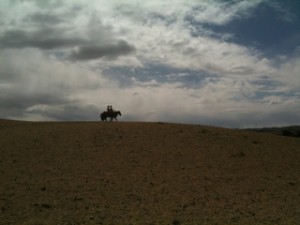
In answer to the questions, the area we were in has an average annual rainfall of around 100-150 mm, so it’s pretty arid and I think some of that may actually be snowfall measurement, not sure on that one. The area that herders move in varies according to seasonal conditions. Typically they have a registered winter camp that they return to each year, this allows them to build some infrastructure to shelter their livestock during winter. Some of these winter camps are really impressive, usually they have outer circular walls made out of stone with slabs of dry dung carved up and piled high to create additional wind breaks. During summer herders will try to preserve any pasture around the winter camp and there are occasional arguments amongst herders trying to secure their winter pastures. Some herders will move only in a radius of about 20-30km while others will travel for hundreds of kilometres, again this probably comes down to having both the means and drive.
Water points are quite close by Australian standards but an increasing number of wells are out of action as nobody seems responsible for their maintenance. It would seem logical that some of the money bought in from mining could be used for water point upkeep but I guess that remains to be seen. Most of the herders had noticed the standing water level in the wells was dropping. Some had made ingenious lever action pumps using an old tyre tube. One old camel herder had made a really effective counter balance bucketing system to reach water that was further than he could reach with a bucket on a stick. I guess the interesting factor in all of this is that the country is un-owned and herders basically co-operate in the use of pastures and wells.

Our translator, Chimeg, showed a lot of diplomacy; often she would introduce us as an Australian goat herder who was travelling the world looking at goat herding accompanied by an environmental scientist (Jane) who was doing her doctorate on the differences between Inner Mongolia and the Mongolian Gobi. Of course it was the complete opposite but when introduced like that and producing photos of our goats and asking them about theirs, the ice was broken and we enjoyed some fantastic unrestrained conversations. We even had some herders show us the gold they had found which was extremely unusual and an indicator of how accepted and trusted we were simply because we shared a common occupation and interests.
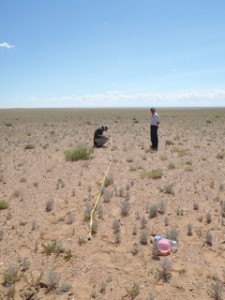
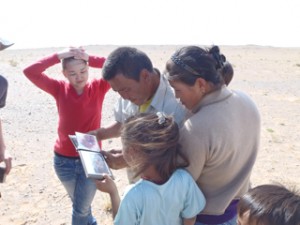
looking at pictures of home
I am forever grateful to Jane Addison for letting me tag along on her PhD research and ‘nobody knows the trouble she’s seen.’ Thanks Jane for taking a huge risk in inviting me along given that you didn’t know me from a bar of soap. Turns out we had heaps in common including a dangerous sense of humour, a definitive lack of “preciousness,” and now an abiding loathing of “you aint nothing but a hound dog” and an overuse of the phrase ‘I beseech you,’ when it comes to changing the music being blasted from the car stereo.
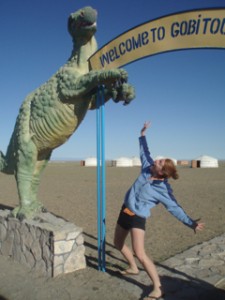
I’m also really grateful for Chimeg’s company on the trip. At just 23 with a bright future in front of her, she provided an interesting dynamic with her educated Mongolian insights. Chimeg and I had the best time horse riding together, we hired a couple of tough little ponies and delighted in terrorising Italian tourists by galloping flat knacker past them like a pair of unruly kids up to mischief. We had these ponies scaling hills so steep that to quote my grandfather, ‘we had to empty the horse dung out of the crown of our hats when we got to the bottom.’ Chimeg spent her childhood summers on horseback like a true Mongolian helping her grandmother who is still a herder in the cold north. Riding a Mongolian pony has been a long held dream of mine and I reckon Chingis Khaan would have signed us up.
It has simply been the best of trips and allowed me the time, space, company and environment to get my head and heart together and focus on the task at hand.
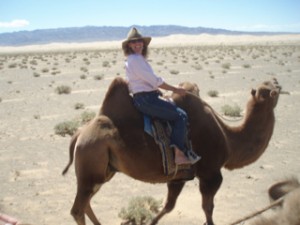
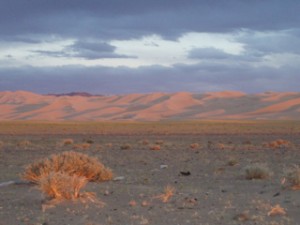

Getting back to Australia is the easy part, from the airport home is always an arduous journey but last night’s was pretty tough. I arrived back in Sydney after an overnighter from Beijing on Thursday morning and was met by my brother who took me to visit my folks and sister near Bathurst then onto Dubbo the following day. I caught a plane to Broken Hill and was met by my daughter Matilda. We then had to wait for Will’s plane to get in from Adelaide which was delayed due to the rough weather being experienced down there. We began the long journey home around 9pm, driving through the rain, arriving home at 2:30 am after 500 km of wet roads, 200 km of them muddy. I’m a little weary today but it is great to see the place looking so green, another 24mm or rain last night. Only 4 days to get station work caught up and then head back down to Broken Hill and onto Canberra for the start of the Nuffield Global Focus Tour, you don’t have to be mad or hyper but I’m finding it helps.

























































































































